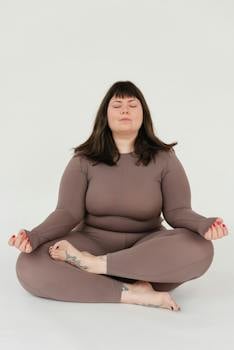

-
Table of Contents
Find peace in the midst of anxiety with Daily Anxiety Relief's quick mindfulness exercises.
Introduction
Introduction: Daily Anxiety Relief: Quick Mindfulness Exercises to Find Peace
In today's fast-paced and demanding world, anxiety has become a common struggle for many individuals. The constant pressure and stress can take a toll on our mental well-being, affecting our overall quality of life. However, there are simple yet effective mindfulness exercises that can provide daily anxiety relief and help us find peace amidst the chaos. By incorporating these quick mindfulness exercises into our daily routine, we can cultivate a sense of calm, reduce anxiety, and improve our overall mental health. In this guide, we will explore various mindfulness techniques that can be easily practiced throughout the day, empowering us to find peace and tranquility in the midst of our busy lives.
Deep Breathing Techniques for Instant Anxiety Relief
Daily Anxiety Relief: Quick Mindfulness Exercises to Find Peace
In today's fast-paced world, it's no wonder that anxiety has become a common issue for many people. The constant pressure to perform, the never-ending to-do lists, and the overwhelming expectations can all contribute to feelings of stress and anxiety. Fortunately, there are simple mindfulness exercises that can provide instant relief from anxiety, allowing you to find peace in the midst of chaos.
One of the most effective techniques for instant anxiety relief is deep breathing. Deep breathing exercises have been used for centuries to calm the mind and relax the body. By focusing on your breath, you can bring your attention away from anxious thoughts and into the present moment.
To begin, find a quiet and comfortable place to sit or lie down. Close your eyes and take a moment to notice how you're feeling. Are there any areas of tension or discomfort in your body? Take note of these sensations without judgment.
Now, take a slow, deep breath in through your nose, allowing your belly to expand as you fill your lungs with air. Hold your breath for a moment, and then exhale slowly through your mouth, releasing any tension or stress with each breath. As you breathe out, imagine that you're letting go of all your worries and anxieties.
Continue this deep breathing pattern for several minutes, focusing on the sensation of your breath entering and leaving your body. If your mind starts to wander, gently bring your attention back to your breath without judgment. Remember, the goal is not to stop your thoughts, but rather to observe them without getting caught up in them.
Another effective deep breathing technique is the 4-7-8 breath. This technique involves inhaling for a count of four, holding the breath for a count of seven, and exhaling for a count of eight. This pattern helps to slow down your heart rate and activate the body's relaxation response.
To practice the 4-7-8 breath, sit or lie down in a comfortable position and close your eyes. Take a deep breath in through your nose for a count of four, allowing your belly to rise. Hold your breath for a count of seven, and then exhale slowly through your mouth for a count of eight. Repeat this cycle three more times, focusing on the rhythm of your breath and the sensation of relaxation with each exhale.
In addition to deep breathing exercises, incorporating mindfulness into your daily routine can also help to alleviate anxiety. Mindfulness involves paying attention to the present moment with curiosity and without judgment. By practicing mindfulness, you can train your mind to let go of worries about the past or future and focus on what's happening right now.
One simple mindfulness exercise is the body scan. To do this exercise, find a comfortable position and close your eyes. Begin by bringing your attention to your feet and slowly move your awareness up through your body, noticing any sensations or areas of tension. As you scan each part of your body, imagine sending your breath to that area, allowing it to relax and release any tension.
By incorporating these quick mindfulness exercises into your daily routine, you can find relief from anxiety and cultivate a sense of peace and calm. Remember, practice is key, so try to set aside a few minutes each day to engage in these exercises. With time and consistency, you'll discover that you have the power to find peace within yourself, no matter what challenges you may face.
Simple Meditation Practices to Calm an Anxious Mind

Daily Anxiety Relief: Quick Mindfulness Exercises to Find Peace
In today's fast-paced world, it's no wonder that anxiety has become a common issue for many people. The constant demands and pressures of daily life can easily overwhelm us, leaving us feeling stressed and anxious. Fortunately, there are simple mindfulness exercises that can help calm an anxious mind and bring a sense of peace and tranquility.
One of the most effective mindfulness practices for anxiety relief is deep breathing. Taking slow, deep breaths can help activate the body's relaxation response and reduce feelings of stress. To practice deep breathing, find a quiet and comfortable place to sit or lie down. Close your eyes and take a deep breath in through your nose, allowing your belly to expand. Hold your breath for a few seconds, and then exhale slowly through your mouth. Repeat this process several times, focusing on the sensation of your breath entering and leaving your body.
Another helpful mindfulness exercise for anxiety relief is body scan meditation. This practice involves bringing your attention to different parts of your body, noticing any sensations or tension that may be present. To begin, find a comfortable position and close your eyes. Start by bringing your attention to your feet, noticing any sensations you may feel. Slowly move your attention up through your legs, hips, abdomen, chest, arms, and finally to your head. As you scan each part of your body, try to release any tension or tightness you may be holding. This practice can help you become more aware of your body and release physical tension that may contribute to feelings of anxiety.
Mindful walking is another effective exercise for anxiety relief. This practice involves bringing your full attention to the act of walking, noticing the sensations in your feet and legs as they make contact with the ground. To practice mindful walking, find a quiet and safe place to walk, such as a park or a quiet street. As you walk, focus on the sensation of your feet touching the ground, the movement of your legs, and the rhythm of your breath. If your mind starts to wander, gently bring your attention back to the present moment and the act of walking.
Visualization is another powerful mindfulness technique for anxiety relief. This practice involves using your imagination to create a mental image that promotes relaxation and calmness. To practice visualization, find a quiet place to sit or lie down. Close your eyes and imagine yourself in a peaceful and serene environment, such as a beach or a forest. Visualize the sights, sounds, and smells of this place, allowing yourself to fully immerse in the experience. This practice can help shift your focus away from anxious thoughts and bring a sense of peace and tranquility.
Incorporating these simple mindfulness exercises into your daily routine can help you find relief from anxiety and bring a sense of peace and calmness to your life. Whether it's deep breathing, body scan meditation, mindful walking, or visualization, these practices can help you become more present and aware of the present moment. By taking a few moments each day to engage in these exercises, you can cultivate a greater sense of peace and well-being in your life. So why not give them a try and experience the benefits for yourself?
Effective Visualization Exercises to Reduce Daily Anxiety
Effective Visualization Exercises to Reduce Daily Anxiety
Visualization exercises can be a powerful tool in reducing daily anxiety and finding peace. By using the power of your imagination, you can create a mental image that promotes relaxation and calmness. These exercises can be done anywhere, at any time, and can provide immediate relief from anxiety. In this article, we will explore some effective visualization exercises that you can incorporate into your daily routine.
One popular visualization exercise is the "Safe Place" technique. Begin by finding a quiet and comfortable space where you can relax. Close your eyes and take a few deep breaths to center yourself. Now, imagine a place where you feel completely safe and at peace. It could be a beach, a forest, or even a cozy room. Picture every detail of this place in your mind - the colors, the sounds, the smells. Allow yourself to fully immerse in this mental image and feel the sense of calmness and security it brings.
Another visualization exercise that can help reduce anxiety is the "Balloon Release" technique. Start by sitting or lying down in a comfortable position. Take a few deep breaths to relax your body and mind. Now, imagine that you are holding a balloon in your hand. This balloon represents your worries and anxieties. As you exhale, visualize all your worries and anxieties being released into the balloon. Watch as the balloon slowly floats away, taking your worries with it. Feel the lightness and relief as you let go of these burdens.
The "Positive Affirmations" technique is another effective visualization exercise. Begin by choosing a positive affirmation that resonates with you. It could be something like "I am calm and at peace" or "I am in control of my thoughts and emotions." Close your eyes and repeat this affirmation to yourself, visualizing it as a written statement or an image in your mind. As you repeat the affirmation, imagine yourself embodying its qualities and feeling a sense of calmness and peace wash over you.
A variation of the "Positive Affirmations" technique is the "Future Visualization" exercise. Start by imagining a future scenario where you are free from anxiety and living a fulfilling life. Picture yourself engaging in activities that bring you joy and contentment. Visualize the details of this scenario - the sights, the sounds, the emotions. Allow yourself to fully experience the positive feelings associated with this future vision. By visualizing a positive future, you can shift your focus away from anxiety and towards a more optimistic outlook.
Incorporating these visualization exercises into your daily routine can provide significant relief from daily anxiety. Whether you choose to practice them in the morning, during a break at work, or before bed, they can help you find peace and calmness in the midst of a hectic day. Remember to approach these exercises with an open mind and a willingness to let go of negative thoughts and emotions. With practice, you can harness the power of visualization to reduce anxiety and cultivate a sense of inner peace.
Q&A
1. What are some quick mindfulness exercises for daily anxiety relief?
Some quick mindfulness exercises for daily anxiety relief include deep breathing exercises, body scans, and grounding techniques.
2. How can deep breathing exercises help with anxiety relief?
Deep breathing exercises help activate the body's relaxation response, reducing anxiety symptoms by slowing down the heart rate, lowering blood pressure, and promoting a sense of calm.
3. What are grounding techniques and how can they help with anxiety relief?
Grounding techniques involve focusing on the present moment and connecting with the physical sensations in your body or your surroundings. They help redirect anxious thoughts and bring a sense of stability and calmness.
Conclusion
In conclusion, daily anxiety relief through quick mindfulness exercises can be an effective way to find peace. These exercises provide individuals with practical tools to manage their anxiety and promote a sense of calmness and well-being. By incorporating these exercises into their daily routine, individuals can experience a reduction in anxiety levels and improve their overall mental health.












